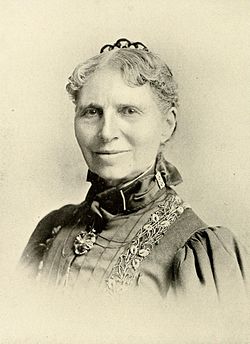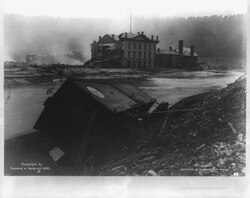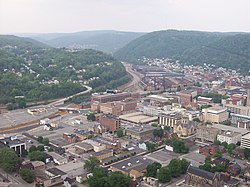The 1889 Johnstown Flood was a disaster which occurred on the 31st of May 1889 when the South Fork Dam on the Little Conemaugh River in central Pennsylvania burst, flooding the settlement of Johnstown 23 kilometers downstream from the dam. For a time the volume of water gushing stream equaled the flow rate of the Mississippi River, a level of water-flow which Johnstown was simply not built to resist. The town was largely destroyed by the flood, causing the equivalent of half a billion dollars’ worth of damage in modern terms, while 2,208 people lost their lives. Yet Johnstown was not abandoned in the aftermath of it. Instead, owing to its role as a metallurgical center, it was quickly rebuilt and actually expanded massively over the next three decades. The flood was also important in the early development of the Red Cross and compensation law in the United States.[1]
The 1889 Johnstown Flood chronology of eventsThe 1889 Johnstown Flood chronology of events
A village had first been settled at Johnstown in 1770 as the Pennsylvania colony began expanding westwards into the central regions of the modern-day state, but it owed its real emergence to Joseph Jahns or Johns Schantz, a Swiss-German immigrant to the United States, in the 1790s, after whom the name Johnstown was applied to it. In the 1830s it became a major transport node in the region as it became a stopping point on the Pennsylvania Main Line Canal. It was also at this time that the South Fork Dam was built upstream on the Little Conemaugh River from Johnstown. Although the canal soon became redundant owing to the advent of the railways, a train stop was established at Johnstown and it maintained its position as an important regional center. This was furthered with the foundation of the Cambria Iron Company of Johnstown here, which for a time became the leading steel manufacturer in the United States. The population grew accordingly, going from 6,000 people in 1870 to over 8,000 in 1880 and expanding to well over 20,000 by the late 1880s.[2]

Johnstown’s major growth in the 1870s and 1880s was nearly completely undone by the events of the 31st of May 1889. There was unusually heavy rainfall in Pennsylvania that early summer and this eventually caused South Fork Dam, which was an earthwork dam rather than one built with concrete, to burst on the final day of May, releasing 14.5 million cubic meters of water into the Little Conemaugh River from Lake Conemaugh, an artificial lake created above the dam when it was erected. Johnstown, which was 23 kilometers downstream, was hit with the full force of the water which was released as the dam burst. The wave was up to forty foot high and travelling at 65 kilometers per hour. It levelled much of the town that afternoon and killed over 2,000 people, while creating over half a billion pounds’ worth of damage in modern terms. At the time, it was the worst disaster of its kind in the history of the United States.[3]
Stock was taken of the damage in the days that followed. It took three days for a large fire which had started when the water receded to be put out and dynamite was needed to clear a huge mound of debris created by the flood. The Cambria Ironworks had been badly damaged, but after an initial cleanup was reopened gradually from the 6th of June, just a week after the flood. Meanwhile charitable and humanitarian aid began arriving in the shape of money and a delegation from the American Red Cross, which had been founded in 1881 in New York City by Clara Barton. Barton arrived in person to oversee the disaster relief.[4]
Extent of migration following the 1889 Johnstown FloodExtent of migration following the 1889 Johnstown Flood
In the weeks and months that followed legal disputes developed between the townspeople and the owners of the Cambria Ironworks and the South Fork Fishing and Hunting Club, the latter of which had made modifications to the dam not long before it burst and were deemed culpable for the flood. However, the club managed to successfully argue that the flood was caused by a force majeure, an act of god and so they were not responsible, a decision which ultimately led to changes in American insurance law. Despite this, funding to rebuild Johnstown was received from far and wide, including from Gilded Age ‘robber barons’ such as Andrew Carnegie and Henry Clay Frick.[5]

With money coming in to rebuild migration away from the town was avoided and instead it was revitalized. In fact, people even started arriving from Philadelphia and New York to settle in Johnstown as new jobs in construction became available to rebuild the town. As a consequence, much like how Chicago actually expanded as a city in the decades following the Great Fire of 1871, Johnstown experienced a boom after the flood. The population surged to 35,000 people by 1900 and to 55,000 in 1910, peaking around 1920 at 67,000 people. Many of these were people born in Europe who had arrived to New York and Philadelphia before heading west to Johnstown. Such was the need for workers that the Johnstown authorities actively recruited African American workers from the southern states and during this period of the Great Migration the African American population of Johnstown increased from just a few dozen in the 1900s to 3,000 by the early 1920s.[6]
Demographic impact of the 1889 Johnstown FloodDemographic impact of the 1889 Johnstown Flood

Ultimately the demographic impact of the flood was reversed in the twentieth century. While Johnstown’s population increased three-fold or more down to 1920, it stagnated thereafter as the railways and the ironworks became less vital to the Pennsylvania economy. With the decline of the manufacturing basis of the economy in the region from the 1950s onwards, leading to the creation of the so-called ‘Rust Belt’, the population of Johnstown fell from 63,000 people in 1950 to 53,000 a decade later, then 42,000 in 1970 and 35,000 by 1980. This depopulation was fueled by further, smaller floods in 1936 and 1977. Where the flood of 1889 had been counteracted by the economic opportunities which life in Johnstown presented at that time, this was no longer the case by the second half of the twentieth century and many people left owing to the flood of 1977. By the end of the century just 24,000 people lived here and today the number has fallen to 18,000. Hence, while the flood of 1889 had the effect of expanding the population of Johnstown in the short run, the shifting economic forces of the United States in the twentieth century have seen the town return to something like its pre-flood population in the early 2020s.[7]
See alsoSee also
Explore more about the 1889 Johnstown FloodExplore more about the 1889 Johnstown Flood
- 1880 United States Federal Census record collection on MyHeritage
- 1890 United States Federal Census record collection on MyHeritage
- 1900 United States Federal Census record collection on MyHeritage
- Pennsylvania Newspapers, 1795-2009 record collection on MyHeritage
- Story of Johnstown record collection on MyHeritage
- It Is Well With My Soul: Finding Ancestors Amid the Rubble of Disaster and Misfortune at Legacy Family Tree Webinars
References
- ↑ https://www.jaha.org/attractions/johnstown-flood-museum/flood-history/facts-about-the-1889-flood/
- ↑ https://www.britannica.com/place/Johnstown-Pennsylvania
- ↑ https://www.jaha.org/attractions/johnstown-flood-museum/flood-history/facts-about-the-1889-flood/
- ↑ https://www.jaha.org/attractions/johnstown-flood-museum/flood-history/the-flood-and-the-american-red-cross/
- ↑ https://www.history.com/news/how-americas-most-powerful-men-caused-americas-deadliest-flood
- ↑ https://www.jaha.org/attractions/heritage-discovery-center/johnstown-history/johnstowns-immigration-history/
- ↑ https://www.biggestuscities.com/city/johnstown-pennsylvania

